A Top Rheumatologist Says to Eat This Daily to “Lubricate” Stiff Joints (According to orthopedic surgeon)
Imagine waking up without that familiar grinding sensation in your knees, or walking up stairs without wincing—this isn’t wishful thinking, it’s possible with the right foods on your plate.
You know that stiffness when you first get out of bed? The pain when you open a jar or climb stairs? That’s your body telling you something important: your joints need better fuel.
Most people reach for pills. But what if you could ease that pain by changing what you eat?
This article will show you exactly which foods help your body make more synovial fluid—that’s the natural oil that keeps your joints moving smoothly. You’ll learn the 15 foods that doctors recommend most, how much to eat, and when you can expect to feel better.
And the best part? You probably already have some of these foods in your kitchen.
Your 7-Day Meal Plan!
Click on any block to flip it over!
Day 1 Meals
Breakfast: Steel-cut oats with blueberries, walnuts, and chia seeds
Snack: Green tea and 2 squares dark chocolate
Lunch: Salmon salad with mixed greens, avocado, and olive oil dressing
Dinner: Bone broth soup with chicken, vegetables, and brown rice
Day 2 Meals
Breakfast: Scrambled eggs with spinach and whole grain toast
Snack: Small handful of almonds
Lunch: Lentil soup with a side salad
Dinner: Grilled chicken with roasted vegetables (drizzled with turmeric and olive oil) and quinoa
Day 3 Meals
Breakfast: Smoothie with berries, spinach, chia seeds, and avocado
Snack: Apple slices with almond butter
Lunch: Sardines on whole grain crackers with cherry tomatoes
Dinner: Tofu stir-fry with ginger, garlic, and broccoli over brown rice
Day 4 Meals
Breakfast: Plain yogurt with strawberries and walnuts
Snack: Green tea and a small orange
Lunch: Black bean and vegetable burrito bowl with avocado
Dinner: Baked salmon with kale (sautéed with garlic) and sweet potato
Day 5 Meals
Breakfast: Whole grain toast with avocado and a poached egg
Snack: Handful of mixed berries
Lunch: Chicken and vegetable soup (made with bone broth)
Dinner: Turkey meatballs with whole wheat pasta and olive oil
Day 6 Meals
Breakfast: Oatmeal with dark chocolate chips, banana, and flax seeds
Snack: Carrots with hummus
Lunch: Tuna salad (with olive oil mayo) on mixed greens
Dinner: Grilled mackerel with roasted Brussels sprouts and quinoa
Day 7 Meals
Breakfast: Veggie omelet (spinach, tomatoes, mushrooms) with whole grain toast
Snack: Green tea and a pear
Lunch: Chickpea salad with olive oil and lemon dressing
Dinner: Bone broth chicken stew with beans and collard greens
Notice the Pattern?
The goal is to make these foods a regular habit:
- Fatty fish or omega-3s
- Multiple servings of veggies
- Whole grains (not refined carbs)
- Healthy fats (olive oil, nuts)
- Lean protein
- Plenty of water!
How Joint Lubrication Actually Works (And Why It Matters)
Your joints have their own built-in oil system. It’s called synovial fluid. Think of it like the oil in your car engine. Without it, metal grinds against metal. With it, everything runs smooth.
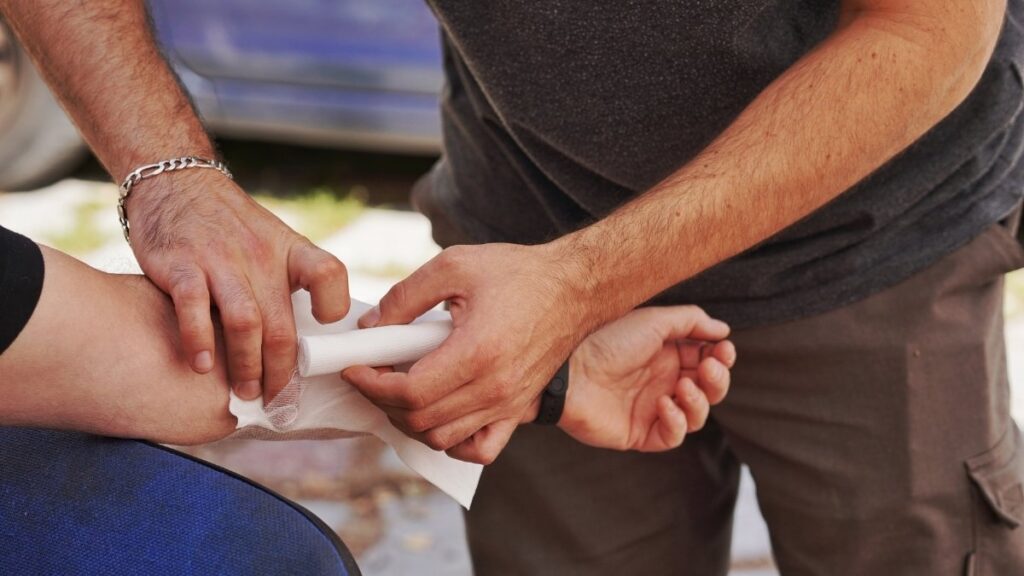
This fluid is mostly water—about 80%. The rest is made of hyaluronic acid, lubricin, and glycosaminoglycans. These compounds cushion your joints, reduce friction, and feed nutrients to your cartilage.
Here’s what most people don’t know: when you’re dehydrated or eating poorly, your body makes up to 30% less synovial fluid. That’s a huge drop.
Your cartilage needs this fluid to stay healthy. Cartilage is the smooth tissue that covers the ends of your bones. It’s 70-80% water. When it doesn’t get enough fluid, it wears down five times faster.
Men need about 3.7 liters of fluid daily. Women need about 2.7 liters. That’s roughly 15 cups for men and 11 cups for women. Most people drink way less than this. And their joints pay the price.
Without proper lubrication, every step hurts a little more. Every movement grinds away a bit more cartilage. Over time, simple tasks become painful.
The good news? You can fix this. And it starts with something you have right now.
The #1 Most Important Thing for Joint Lubrication (It’s Free)

Water. That’s it. That’s the secret. Before you add any fancy foods or supplements, you need to drink enough water. Because without it, nothing else works.
Here’s why: synovial fluid is 80% water. When you’re dehydrated, your body simply can’t make enough of it. The fluid gets thinner and less effective. Your joints grind more. Pain increases.
Think about a sponge. When it’s dry, it’s stiff and brittle. Add water and it becomes soft and flexible. Your cartilage works the same way.
When you don’t drink enough, your body prioritizes vital organs. Your joints get whatever’s left over. Usually, that’s not much.
Signs your joints need more water:
- Morning stiffness that lasts over 30 minutes
- More pain after sitting for a while
- Joints that crack and pop frequently
- Swelling that won’t go down
How much should you drink? Aim for 8-10 glasses daily. More if you exercise or live somewhere hot.
Here’s an easy trick: drink a full glass of water as soon as you wake up. Your body loses water overnight. This jump-starts your synovial fluid production.
Exercise helps too. When you move, you push water into your synovial fluid. You literally pump lubrication into your joints. That’s why gentle movement often helps stiffness more than sitting still.
But here’s what matters most: you need to drink water consistently. One day won’t fix years of dehydration. But two weeks of good hydration? You’ll feel the difference.
Water is the foundation. Everything else we talk about builds on this base.
15 Foods Rheumatologists Say to Eat Daily to Lubricate Stiff Joints
Based on current research and recommendations from orthopedic surgeons and rheumatologists, these 15 foods provide the nutrients your body needs to produce synovial fluid, reduce inflammation, and protect cartilage.
These aren’t trendy superfoods that cost a fortune. They’re regular foods that work. Doctors see the results in their patients every day.
Let’s look at each one.
Food #1: Bone Broth (The Joint Superfood)

This is the closest thing to liquid gold for your joints.
Bone broth contains the exact same compounds found in expensive joint supplements: glucosamine, chondroitin, and hyaluronic acid. But you’re getting them from real food, not a pill.
When you simmer bones for hours, the collagen breaks down into gelatin. This gelatin gives your body the building blocks it needs to repair cartilage.
It also contains GAGs—glycosaminoglycans. These molecules help your bones slide smoothly past each other without pain or catching.
How much should you drink? About 8-12 ounces daily works well. Or have it 3-4 times per week if daily feels like too much.
You can make your own by simmering chicken or beef bones for 12-24 hours. Add some vegetables and apple cider vinegar (this pulls more minerals from the bones).
Don’t have time to make it? Store-bought works too. Look for organic brands with low sodium. The ingredient list should be short: bones, water, vegetables.
Some people drink it warm like tea. Others use it as a base for soups. Both work.
The taste takes some getting used to if you’re new to it. Start with smaller amounts mixed into soups or stews.
Food #2: Fatty Fish (Salmon, Sardines, Mackerel)
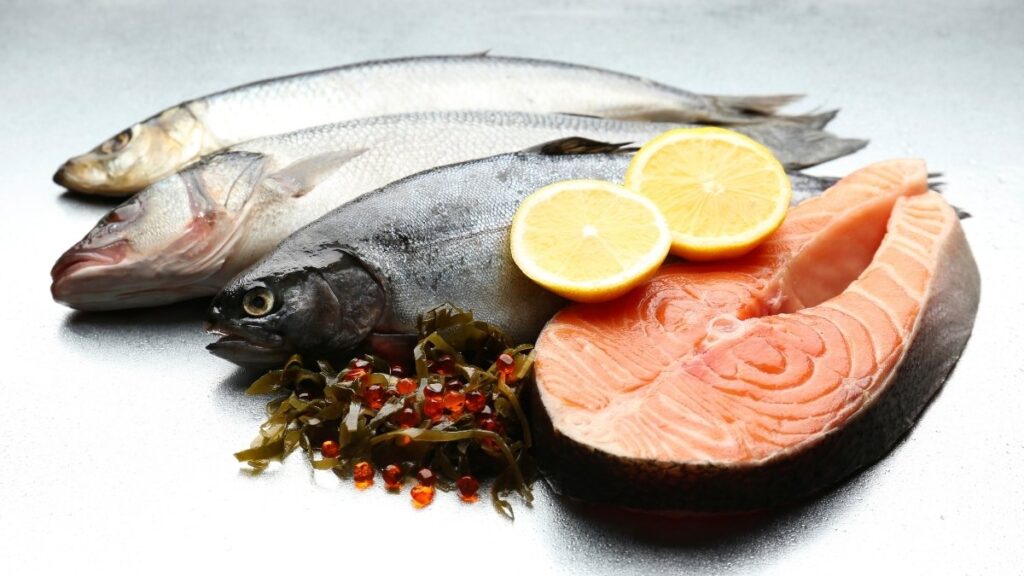
Omega-3 fatty acids are your joints’ best friend.
These fats help maintain synovial fluid—that natural lubricant we talked about. They also tell your body to calm down the inflammation that causes pain.
Studies show something interesting: people who take 600-1,000mg of fish oil daily have less joint stiffness, tenderness, pain, and swelling. The omega-3s actually interfere with the immune cells that cause inflammation.
Eat 3-4 ounces of fatty fish, 2-4 times per week. That’s about the size of a deck of cards.
Best choices:
- Wild salmon (fresh or canned)
- Sardines with bones (you get extra calcium)
- Mackerel
- Herring
Worried about mercury? Stick with smaller fish like sardines. They have less mercury because they’re lower on the food chain.
Canned salmon and sardines are cheap and convenient. Keep a few cans in your pantry for quick meals.
Try this: mash sardines with avocado on whole grain toast. It sounds weird. It tastes amazing. And your joints will love you for it.
Food #3: Extra Virgin Olive Oil
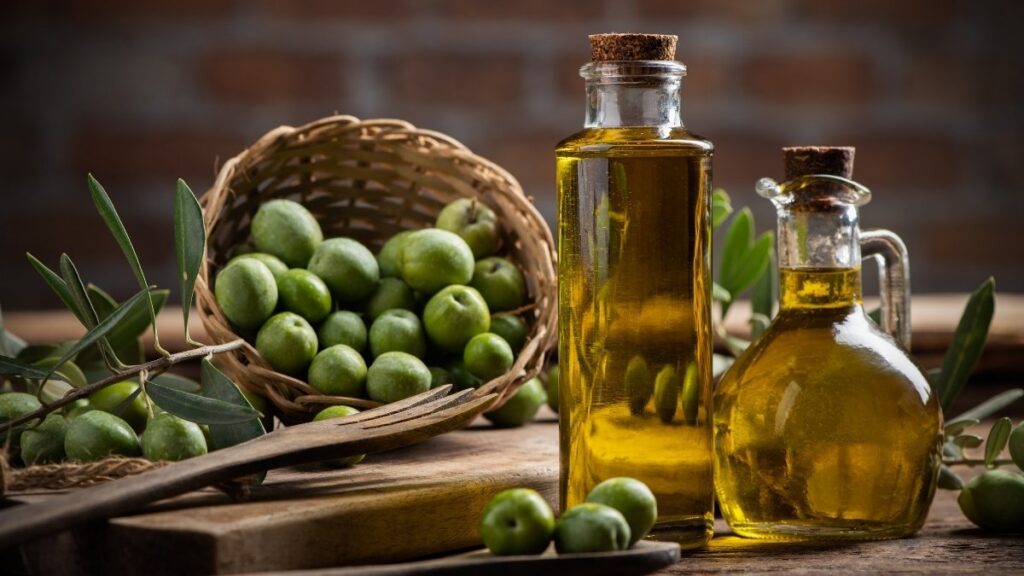
This oil does something special. It contains a compound called oleocanthal that works like ibuprofen in your body.
Oleocanthal blocks the same enzymes that NSAIDs (like Advil) block—the COX-1 and COX-2 enzymes that cause inflammation and pain.
But unlike pills, olive oil doesn’t come with side effects. And you’re getting other nutrients too.
Use 2-3 tablespoons daily. That might sound like a lot, but it’s easy:
- Drizzle it on salads
- Use it for low-heat cooking
- Pour it over roasted vegetables
- Dip whole grain bread in it
One important thing: buy extra virgin olive oil. Regular olive oil doesn’t have the same level of oleocanthal. The extra virgin stuff keeps more of the beneficial compounds.
Keep it in a dark bottle away from heat. Light and heat destroy the good stuff.
Food #4: Dark Leafy Greens (Kale, Spinach, Collards)
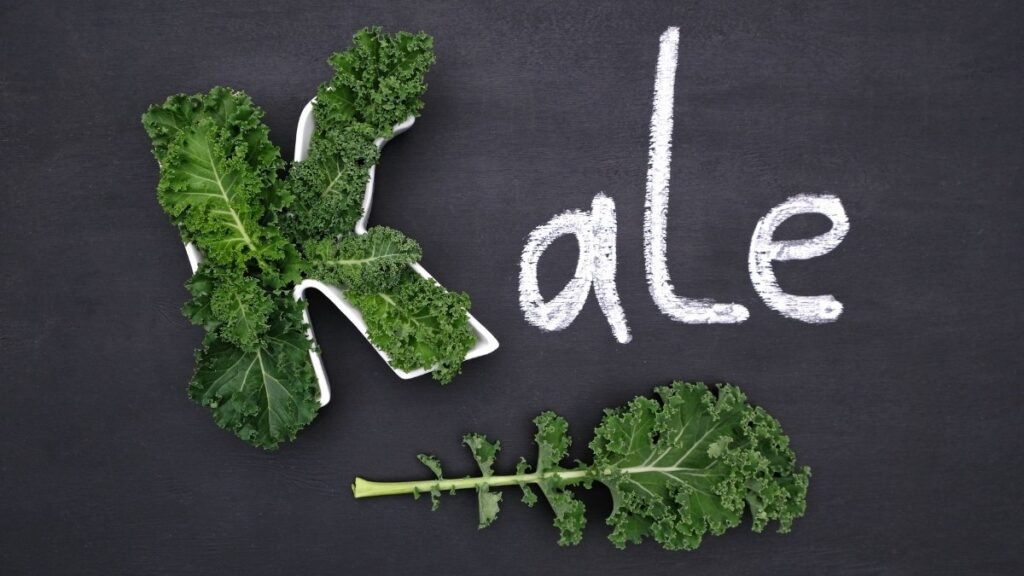
These vegetables are loaded with vitamin K. And vitamin K does something remarkable—it dramatically reduces inflammatory markers in your blood.
Think of inflammation like a fire in your joints. These greens help put out that fire.
They’re also packed with calcium and magnesium. Your bones need these minerals to stay strong. Strong bones mean less stress on your joints.
Eat 1-2 cups daily. That can be raw (in salads) or cooked (which actually makes some nutrients easier to absorb).
Easy ways to eat more:
- Toss a handful of spinach into your morning smoothie (you won’t taste it)
- Sauté kale with garlic and olive oil as a side dish
- Add greens to soups and stews in the last few minutes of cooking
- Make a simple salad with mixed greens
Don’t like the bitter taste of kale? Massage it with a little olive oil and lemon juice before eating. This breaks down the tough fibers and mellows the flavor.
Food #5: Berries (Blueberries, Strawberries, Cherries)

Berries pack a powerful punch against inflammation.
They contain polyphenols—plant compounds that act like tiny firefighters in your body, putting out inflammation before it causes pain.
Cherries deserve special mention. They contain anthocyanins, which give them that deep red color. These anthocyanins are some of the strongest anti-inflammatory compounds you can eat.
Eat 1-1.5 cups daily. Fresh or frozen—both work equally well. Frozen berries are often cheaper and just as nutritious.
Ways to eat them:
- Mix into plain yogurt
- Add to oatmeal or cereal
- Blend into smoothies
- Eat them plain as a snack
Tart cherry juice has the highest concentration of anti-inflammatory compounds. But it’s also high in sugar, so limit it to a small glass (4-6 ounces) if you go this route.
Here’s a pro tip: buy frozen mixed berries. You get variety without waste. And they’re already washed and ready to use.
Food #6: Nuts and Seeds (Walnuts, Almonds, Chia)
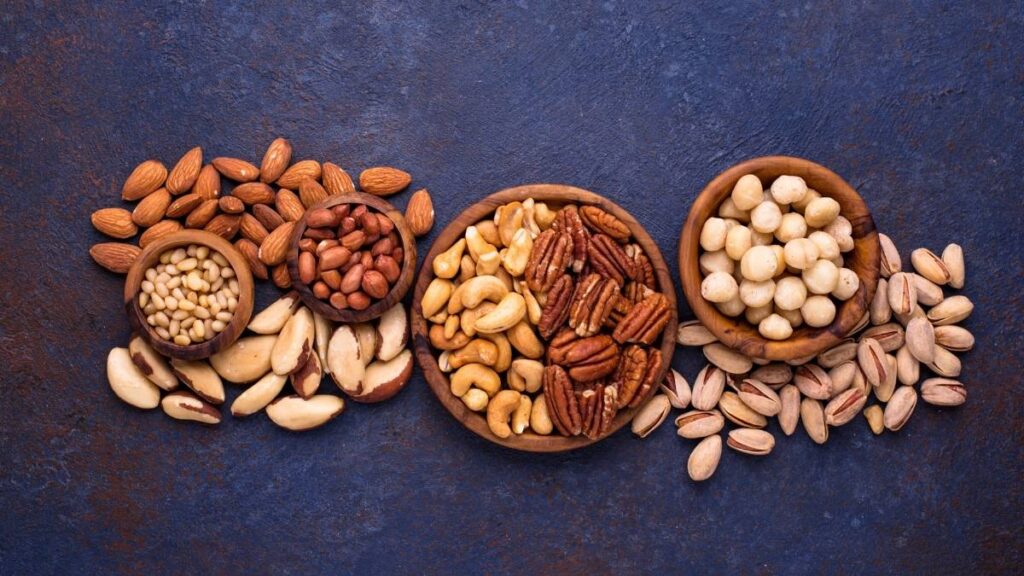
Here’s a surprising fact: people who eat the most nuts have a 51% lower risk of dying from inflammatory diseases like rheumatoid arthritis.
That’s huge. Eating a handful of nuts daily might cut your risk in half.
Nuts give you omega-3 fatty acids (especially walnuts), magnesium, and vitamin E. All three fight inflammation and support joint health.
Eat about 1.5 ounces daily. That’s roughly a small handful or about 1/4 cup.
Best choices:
- Walnuts (highest omega-3 content)
- Almonds (great for calcium and vitamin E)
- Chia seeds (plant-based omega-3s)
- Flax seeds (more plant omega-3s)
Keep it simple. Grab a small handful as a snack. Sprinkle them on salads or oatmeal. Mix them into yogurt.
One warning: nuts are high in calories. Stick to the recommended portion. More isn’t always better here.
Food #7: Turmeric (Curcumin)
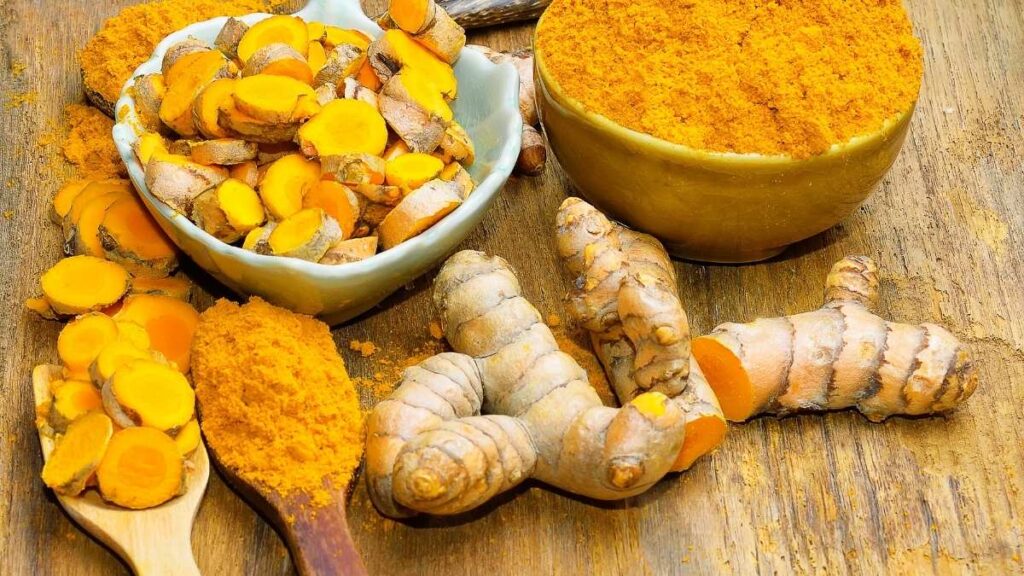
Turmeric might be as effective as anti-inflammatory drugs for both osteoarthritis and rheumatoid arthritis.
The active compound is curcumin. It blocks inflammatory pathways in your body at the cellular level.
In one study, 100 people with osteoarthritis used a turmeric-based treatment for 8 months. They saw real reductions in pain and other symptoms.
Take 500-1000mg of curcumin daily. But here’s the catch: your body doesn’t absorb curcumin well by itself. You need black pepper with it. The piperine in black pepper increases absorption by 2000%.
Ways to use it:
- Add turmeric powder to curries and soups
- Make golden milk (turmeric mixed with warm milk and honey)
- Take it as a supplement that includes piperine
- Mix into smoothies with a pinch of black pepper
Also, eat it with fat. Curcumin absorbs better when combined with healthy fats like olive oil or coconut oil.
Fresh turmeric root works too. Grate it into dishes or juice it.
Food #8: Beans and Lentils
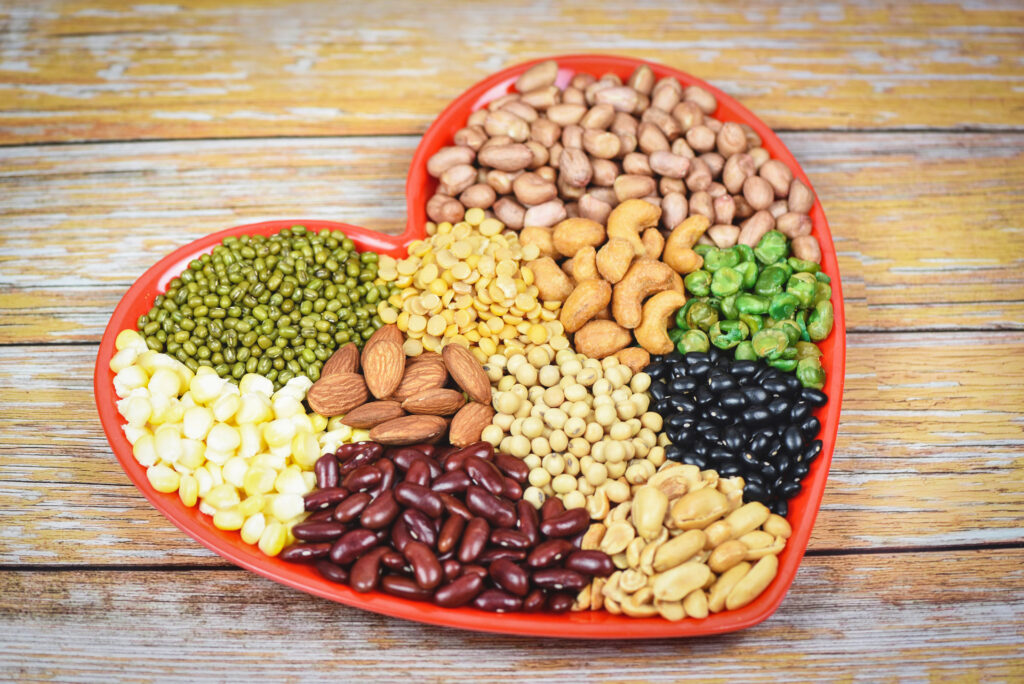
These humble foods do something special—they lower C-reactive protein (CRP). That’s a marker of inflammation in your blood. High CRP means more inflammation and pain.
Beans and lentils are packed with fiber. This fiber helps reduce inflammation throughout your body.
They also provide protein without the inflammatory effects of red meat. Your muscles need protein to support your joints properly.
Black beans especially contain anthocyanins—the same anti-inflammatory compounds found in berries.
Eat 1/2 to 1 cup cooked, 3-4 times per week.
Easy options:
- Black beans in tacos or burritos
- Lentil soup
- Chickpeas roasted as a crunchy snack
- Hummus (made from chickpeas) with vegetables
Canned beans are fine. Just rinse them to remove excess sodium.
New to beans? Start small. Your digestive system needs time to adjust. Begin with 1/4 cup and work your way up.
Food #9: Whole Grains
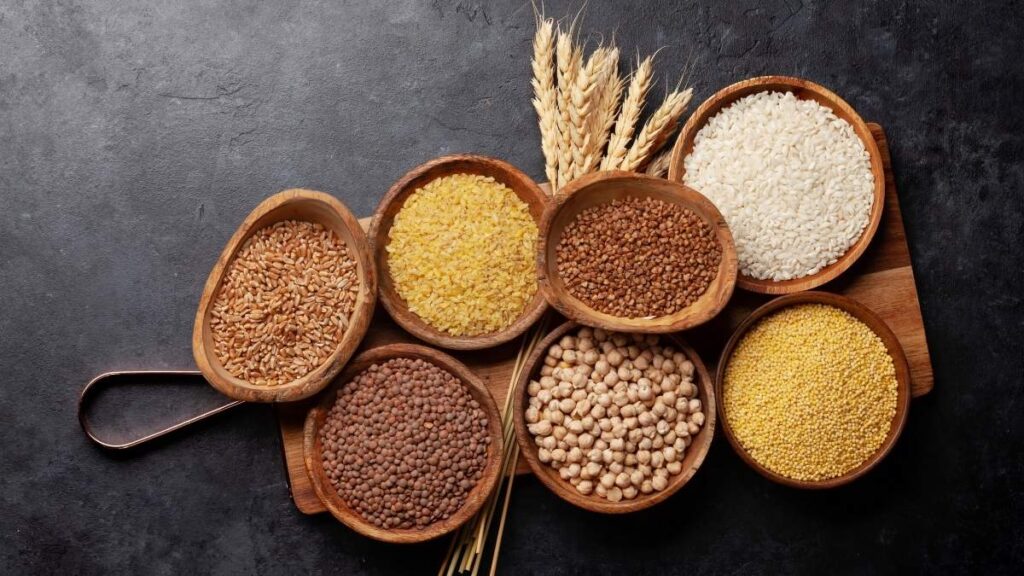
Whole grains create fatty acids in your gut that fight inflammation. But refined grains (like white bread and white rice) do the opposite—they trigger inflammation.
Whole grains also contain phosphorus. This mineral works with calcium to keep your bones strong.
Eat 3-4 servings daily. One serving is:
- 1 slice whole grain bread
- 1/2 cup cooked brown rice or quinoa
- 1/2 cup cooked oatmeal
Best choices:
- Brown rice
- Quinoa
- Steel-cut oats
- Whole wheat bread (check the label—”whole wheat flour” should be the first ingredient)
Start your day with steel-cut oatmeal. It keeps you full and starts the anti-inflammatory process early.
Use quinoa as a side dish or salad base. It cooks in 15 minutes and has more protein than most grains.
Skip anything labeled “enriched” or “refined.” These have been stripped of the beneficial compounds.
Food #10: Green Tea
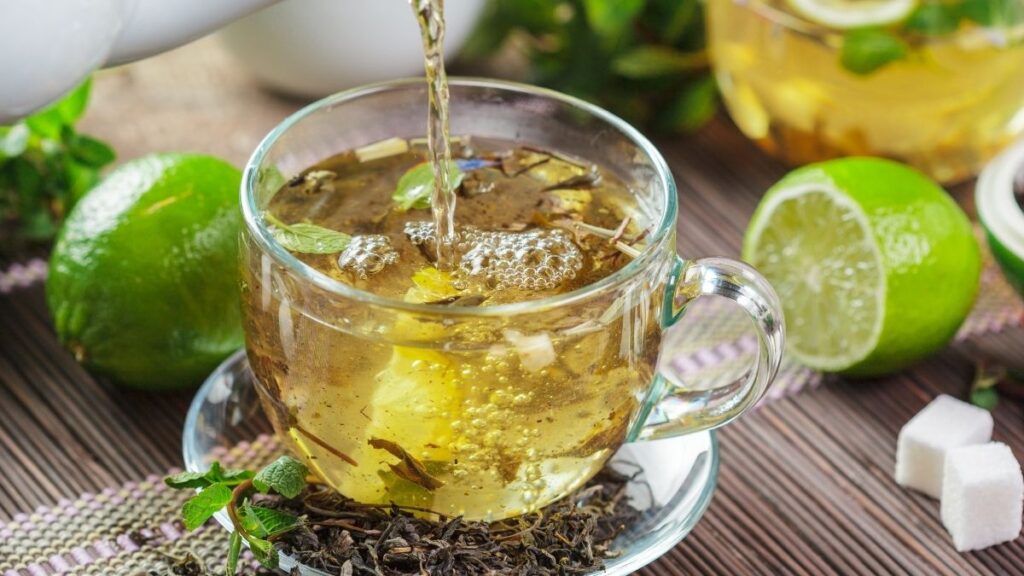
Green tea contains EGCG—a powerful antioxidant that protects your cartilage and bones.
This antioxidant is 100 times stronger than vitamin C and vitamin E. It may lower your risk of both osteoarthritis and rheumatoid arthritis.
Drink 2-3 cups daily for best results.
Brewing tips:
- Steep for 3-5 minutes (longer makes it bitter)
- Don’t use boiling water—let it cool slightly first
- Drink it hot or cold, whatever you prefer
- Choose organic to avoid pesticides
You can drink it plain or add a squeeze of lemon. The vitamin C in lemon actually helps your body absorb more of the beneficial compounds.
Not a fan of the taste? Try different varieties. Sencha and matcha have different flavor profiles. One might appeal to you more.
Green tea does have some caffeine (about half as much as coffee). If you’re sensitive, stick to morning and early afternoon cups.
Food #11: Vitamin D-Rich Foods (Fatty Fish, Eggs, Fortified Dairy)
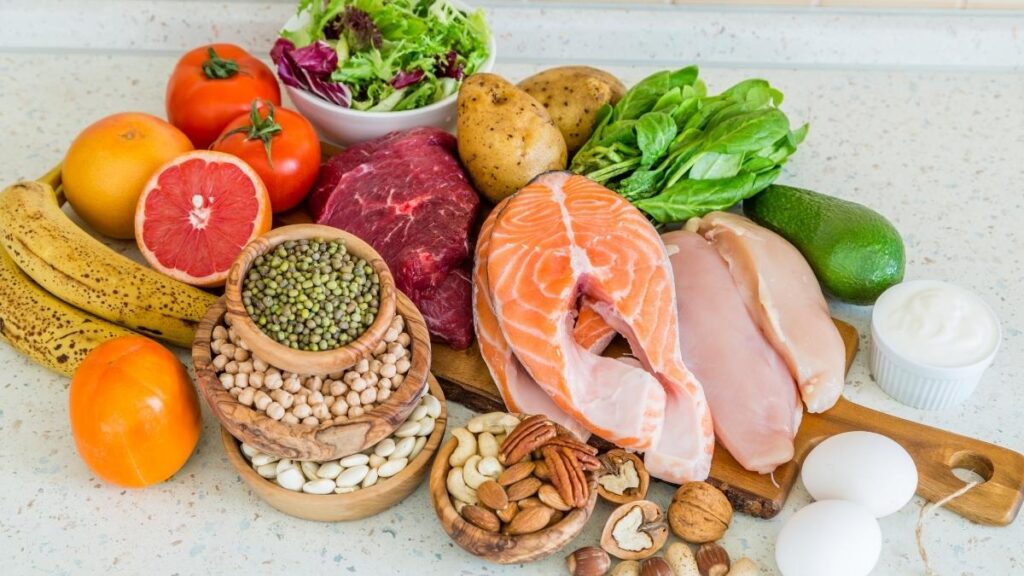
People with rheumatoid arthritis consistently have lower vitamin D levels. That’s not a coincidence.
Vitamin D helps your body absorb calcium. It also fights inflammation and supports your immune system. Your joints need all three.
Get 600-800 IU daily through food. You might need a supplement too—ask your doctor to check your levels.
Best food sources:
- Egg yolks (one egg has about 40 IU)
- Fortified milk (one cup has about 120 IU)
- Fortified orange juice
- Fatty fish like salmon (3 ounces has about 450 IU)
- Mushrooms exposed to UV light
Sardines with bones give you vitamin D and calcium at the same time.
Most people need supplements to reach optimal levels (most doctors recommend 30-50 ng/mL on blood tests). But food sources still matter because they come with other nutrients your body needs.
Food #12: Avocados
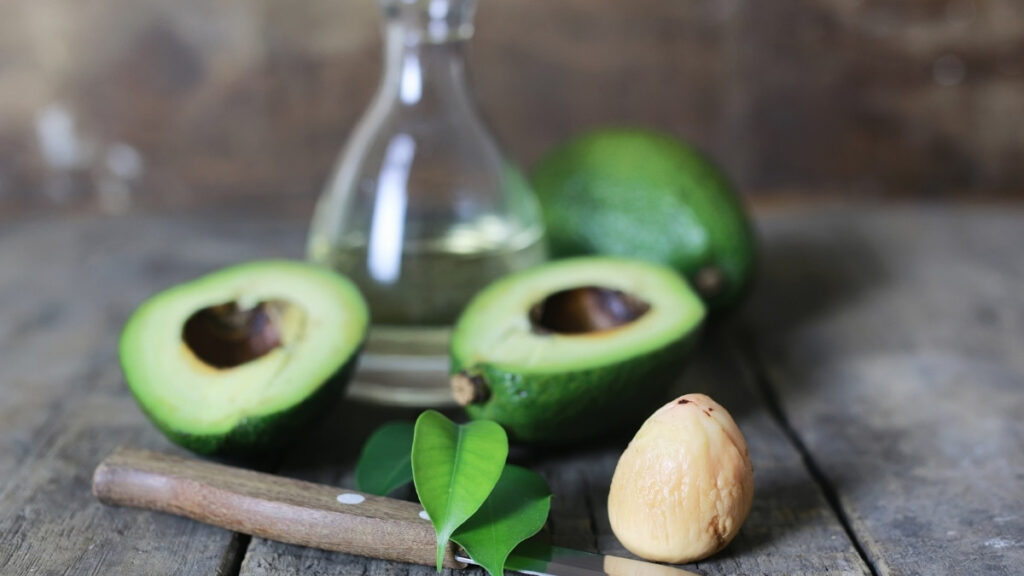
Avocados are packed with anti-inflammatory monounsaturated fat. The same healthy fat in olive oil.
They also contain vitamin E, which has strong anti-inflammatory effects. This combination helps reduce joint pain and stiffness.
Eat 1/2 to 1 avocado daily.
Simple ways to add them:
- Mash onto whole grain toast
- Add to smoothies (makes them creamy without dairy)
- Slice into salads
- Make guacamole
Avocados are high in calories, so watch your portions if you’re trying to lose weight. But don’t avoid them—the fats they contain are exactly what your joints need.
A ripe avocado gives slightly when you press it. Too hard? Let it sit on the counter for a day or two. Too soft? It’s overripe (but still fine for smoothies).
Food #13: Garlic and Ginger
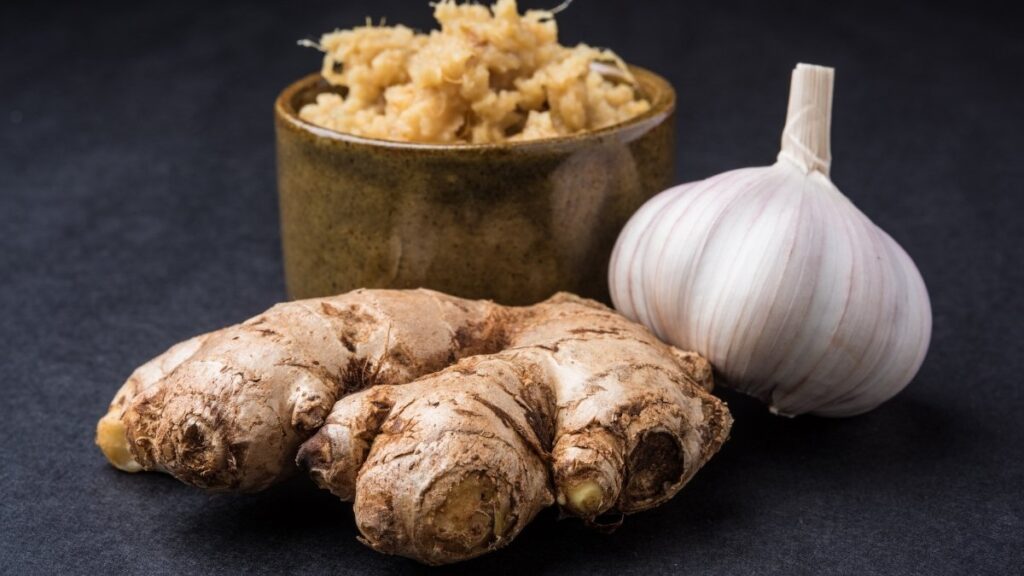
These two ingredients have been used as medicine for thousands of years. Now we know why—they really work.
Garlic contains diallyl disulfide. This compound may limit cartilage damage in your joints. It also has strong anti-inflammatory properties.
Ginger reduces inflammatory compounds throughout your body. Some studies suggest it works as well as ibuprofen for certain types of pain.
Use them liberally in cooking. There’s no specific dose—just use them often.
Easy ways to add more:
- Mince garlic into almost any savory dish
- Add fresh ginger to tea
- Make a ginger-garlic paste and keep it in your fridge
- Stir-fry vegetables with both
Fresh works best, but powdered versions still have benefits. Just use more of the powder (about three times as much) to equal fresh.
Ginger tea is simple: slice fresh ginger, steep in hot water for 10 minutes, add honey and lemon.
Food #14: Dark Chocolate (70%+ Cocoa)
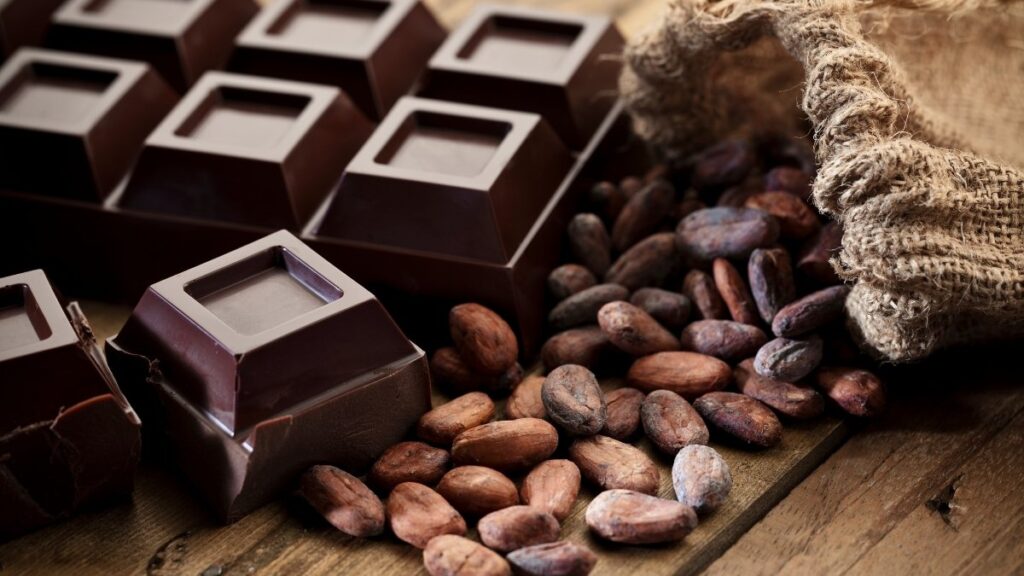
Yes, you can eat chocolate for your joints. But not just any chocolate.
Dark chocolate contains antioxidants that fight inflammation. The higher the cocoa percentage, the more antioxidants you get.
The key is moderation. Chocolate still has sugar and fat. Eat 1-2 ounces (about 2-4 squares) 3-4 times per week.
What to look for:
- 70-85% cocoa content
- Short ingredient list (cocoa, cocoa butter, sugar)
- Minimal added sugar
Pair it with berries for double the anti-inflammatory benefits. Or melt it over a bowl of oatmeal with walnuts.
Milk chocolate doesn’t count. It has too much sugar and not enough cocoa to help.
If you don’t like the bitter taste of dark chocolate, start with 70% and work your way up to higher percentages.
Food #15: Lean Protein (Chicken, Turkey, Tofu)
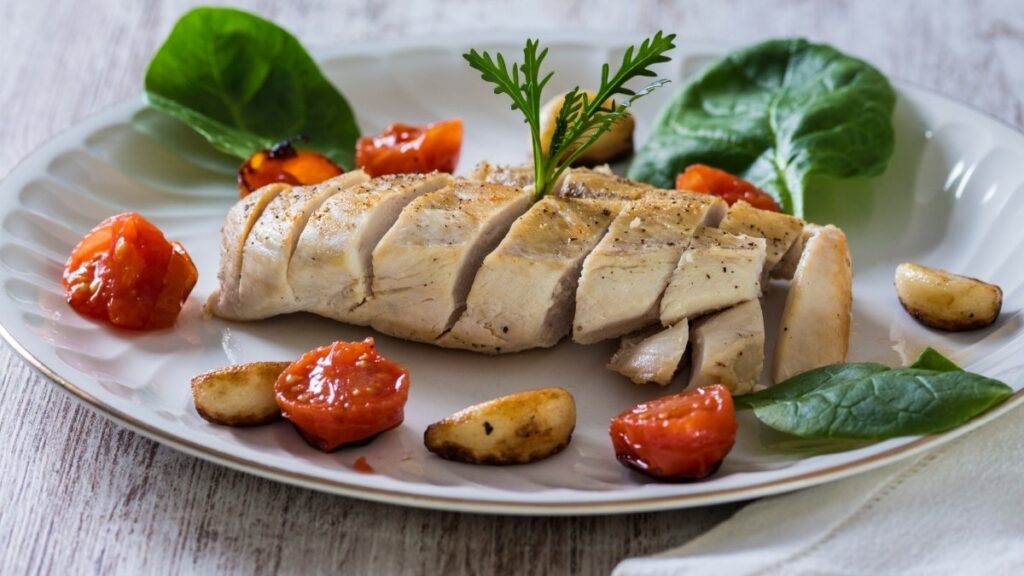
Your cartilage, tendons, and ligaments are made of protein. They need a constant supply to stay healthy and flexible.
Protein also helps your body make synovial fluid. Without enough protein, your joint lubrication suffers.
Eat about 0.8-1 gram of protein per pound of lean body mass. For a 150-pound person, that’s roughly 120-150 grams daily.
Best sources:
- Chicken breast
- Turkey
- Tofu
- Tempeh
- Lean cuts of beef or pork (occasionally)
Avoid processed meats like hot dogs, bacon, and deli meat. These increase inflammation.
Spread your protein throughout the day. Your body can only use so much at once. Three meals with 30-40 grams of protein each works better than one huge serving.
Plant proteins like tofu and tempeh are great options. They give you protein without the saturated fat found in some animal proteins.
Foods to Avoid (They Sabotage Joint Lubrication)
What you don’t eat matters as much as what you do eat.
Foods to Avoid 🚫
What you don’t eat matters as much as what you do! Some foods actively increase inflammation and can break down your joint health. Here’s what to limit or avoid:
Processed Meats
Examples: Hot dogs, bacon, sausage, deli meat.
These contain compounds that worsen osteoarthritis symptoms and are often high in salt, contributing to calcium loss.
Fried Foods
Examples: French fries, fried chicken, donuts.
High heat cooking creates inflammatory compounds (AGEs) that accelerate joint damage.
Sugar Drinks
Examples: Soda, sweet tea, energy drinks.
Sugar triggers widespread inflammation and has been linked to increased rheumatoid arthritis risk.
Refined Carbs
Examples: White bread, white rice, pastries.
These cause blood sugar spikes, which lead to inflammation, and lack beneficial fiber.
High Omega-6 Oils
Examples: Corn oil, soybean oil, regular vegetable oil.
Too much omega-6 (relative to omega-3) promotes inflammation in the body.
Excess Alcohol
While an occasional drink is fine, regular heavy drinking depletes essential joint nutrients and can interfere with bone formation.
Too Much Salt
High sodium intake can lead to calcium loss and fluid retention, potentially increasing joint swelling.
Simple Swaps for Better Joint Health!
You don’t have to be perfect! Aim for 80/20 – eat the good stuff 80% of the time, and don’t stress about the occasional treat.
Some foods actively increase inflammation and break down your joint health. They undo all the good work from the foods above.
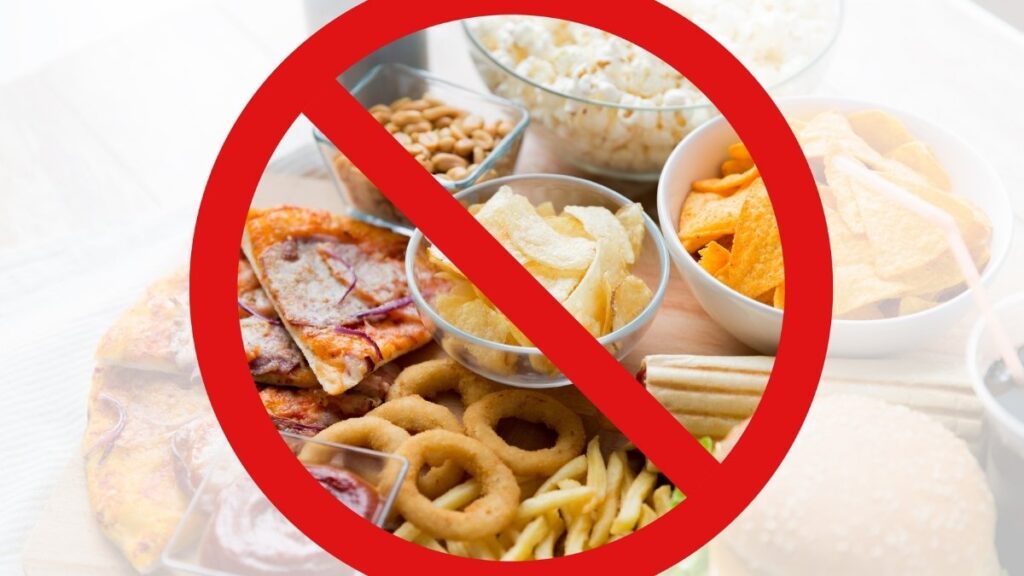
Here’s what to limit or avoid:
Processed meats: Hot dogs, bacon, sausage, deli meat. These contain compounds that worsen osteoarthritis symptoms. They’re also high in salt, which causes calcium loss.
Fried foods: French fries, fried chicken, donuts. The high heat creates inflammatory compounds called AGEs (advanced glycation end products). These accelerate joint damage.
Sugar-sweetened drinks: Soda, sweet tea, energy drinks. Sugar triggers inflammation throughout your body. One study linked sugar-sweetened drinks to increased rheumatoid arthritis risk.
Refined carbs: White bread, white rice, pastries. These spike your blood sugar, which triggers inflammation. They also lack the fiber needed to produce anti-inflammatory compounds.
Vegetable oils high in omega-6: Corn oil, soybean oil, regular vegetable oil. Too much omega-6 compared to omega-3 promotes inflammation. Most Americans eat way too much omega-6.
Excess alcohol: An occasional drink is fine. But regular heavy drinking depletes nutrients your joints need. It also interferes with bone formation.
Too much salt: High sodium causes your body to lose calcium. It also causes fluid retention, which can increase joint swelling.
Make simple swaps:
- Vegetable oil → Olive oil or avocado oil
- White bread → Whole grain bread
- Soda → Water with lemon or green tea
- Chips → Nuts and berries
- Fried foods → Baked or grilled versions
You don’t have to be perfect. Aim for 80/20—eat the good stuff 80% of the time, and don’t stress about the occasional treat.
But the more consistently you avoid inflammatory foods, the better you’ll feel
How Soon Will You Notice Results?
This is the question everyone asks. And the honest answer is: it depends.
But here’s what research shows:
Hydration effects: 3-7 days When you start drinking enough water, your synovial fluid production increases within days. Many people notice morning stiffness improves within a week.
Anti-inflammatory foods: 2-4 weeks Studies show that people who avoid inflammatory foods while eating more anti-inflammatory foods notice improvements within 2 weeks. Joint pain decreases. Stiffness eases up. Movement feels smoother.
Cartilage support: 8-12 weeks Cartilage changes take longer. Your body needs time to repair damage and build new tissue. But most people see measurable improvement in joint function within 3 months.
Individual factors matter:
- How damaged your joints are now
- How consistently you follow the plan
- Your overall health and other medical conditions
- Whether you’re also taking other steps (like exercise and weight management)
Be patient with yourself. You didn’t develop joint problems overnight. They won’t disappear overnight either.
But small improvements compound. Less pain means more movement. More movement means less stiffness. Less stiffness means better quality of life.
Track how you feel. Keep a simple journal:
- Morning stiffness (how long it lasts)
- Pain level during daily activities
- Range of motion
- Energy levels
You might not notice daily changes. But when you look back after 2-3 weeks, you’ll see progress.
And remember: some days will be better than others. That’s normal. Focus on the overall trend, not individual days.
Your Joints Deserve Better
Joint lubrication starts with hydration. Drink 8-10 glasses of water daily. This is the foundation everything else builds on.
The 15 foods we covered work together. They increase synovial fluid, reduce inflammation, and protect your cartilage. Each one plays a specific role.
If you remember nothing else, remember these three:
- Bone broth (builds cartilage and provides joint compounds)
- Fatty fish (reduces inflammation with omega-3s)
- Dark leafy greens (fights inflammatory markers in your blood)
Consistency matters more than perfection. You don’t need to eat perfectly every meal. Aim for 80% of the time. That’s enough to see real results.
Most people notice improvement within 2-4 weeks. Some sooner, some later. Give it time.
Start today by choosing just 3 foods from this list to add to your diet this week. Your joints will thank you. Remember, small changes compound over time—and every healthy meal is a step toward pain-free movement.
These natural joint lubrication foods, recommended by orthopedic surgeons and rheumatologists, offer a safe, effective way to reduce stiff joints and improve mobility without relying solely on medication.
You’ve got this. One meal at a time, one day at a time. Your joints are already getting better.








